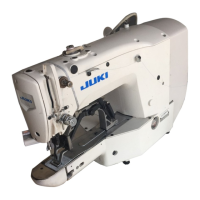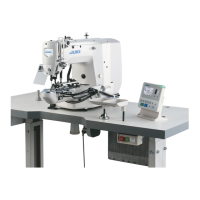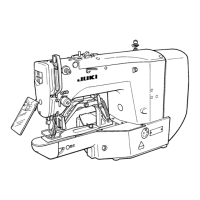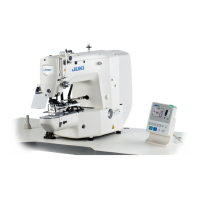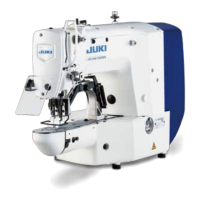−
22
−
11. Detecting mechanism of the button feeder components and the adjustment
WARNING :
Perform the work in the state where the sewing LED goes out so as to prevent accidents caused by abrupt
start of the sewing machine.
*WhenthesensorisON,LED(red)lightsup,andwhen
thesensorisOFF,theLEDgoesout.
Fig.a-
Triple-pawldog
BUT ON
BUT
LED(red)
Fig.a-
1–
1.5mm
Fig.b-
Finepositioning
sensordog
RFIN
RFIN ON
LED(red)
Fig.b-
1–
1.5mm
(1) Adjusting the button positioning detection switch (BUT)
Button positioning detection switch
(hereinafter called BUT) which incorporates a proximity sensor is a sensor to detect
whether a button exists within positioner
when actuating the positioner (triple pawl).
(It turns OFF when a button exists in the positioner or turns ON when it does not detect any button there.)
Draw the iron core of positioning solenoid
when there is no button in positioner
, and the triple pawl will be closed. In
this state, loosen the xing screw of triple pawl dog
, and move the triple pawl dog until BUT
which has been in the
OFF state turns ON. Then further move the triple pawl dog forward from the aforementioned position (Fig. a-
) by 1 to 1.5
mm (Fig. a-
), and tighten the xing screw of the triple pawl dog.
Then, conrm that BUT
turns OFF when the triple pawl clamps a ø10 mm button. Also conrm that BUT
turns ON when
the triple pawl is closed after taking out the button from it.
Be sure to remember that adjustment (2) should be carried out whenever the aforementioned adjustments have been carried
out.
(2) Adjusting the fine positioning completion switch (RFIN)
Fine positioning completion switch
(hereinafter called RFIN) which incorporates a proximity switch is the sensor to detect
a button when the button is set on the carrier pin.
Place a ø10 mm button in positioner
, draw the iron core of positioning solenoid
to make the triple pawl clamp the
periphery of the button. In this state, loosen the xing screw of ne positioning sensor dog
, and move the RFIN
to
the position where the RFIN
changes from its OFF state to ON state (Fig. b-
). Then move back the RFIN
from the
aforementioned position by 1 to 1.5 mm (Fig. b-
), and tighten the xing screw.
Then conrm rst that the RFIN
turns OFF when the triple pawl clamps a ø10 mm button. Remove the button from the
triple pawl, and conrm that the RFIN
turns ON when the triple pawl clamps the periphery of the lower section of the work
attachment
.
Note, however, that adjustment (1) should have been completed before starting this adjustment.
(Caution) TheRFINfunctionstodetectabuttonwhenthebuttoniscompletelysetonthecarrierpinby
turningitself ON/OFF(thedifference betweentheoutside diameterofthe buttonandthatof thework
attachment)andtoopen/closetheshutter.
Itisnotnecessarytore-adjustswitches(1)and(2)whenthecurrentbuttonisreplacedwithabuttonof
whichdiameterisdifferentfromthatofthecurrentbutton.

